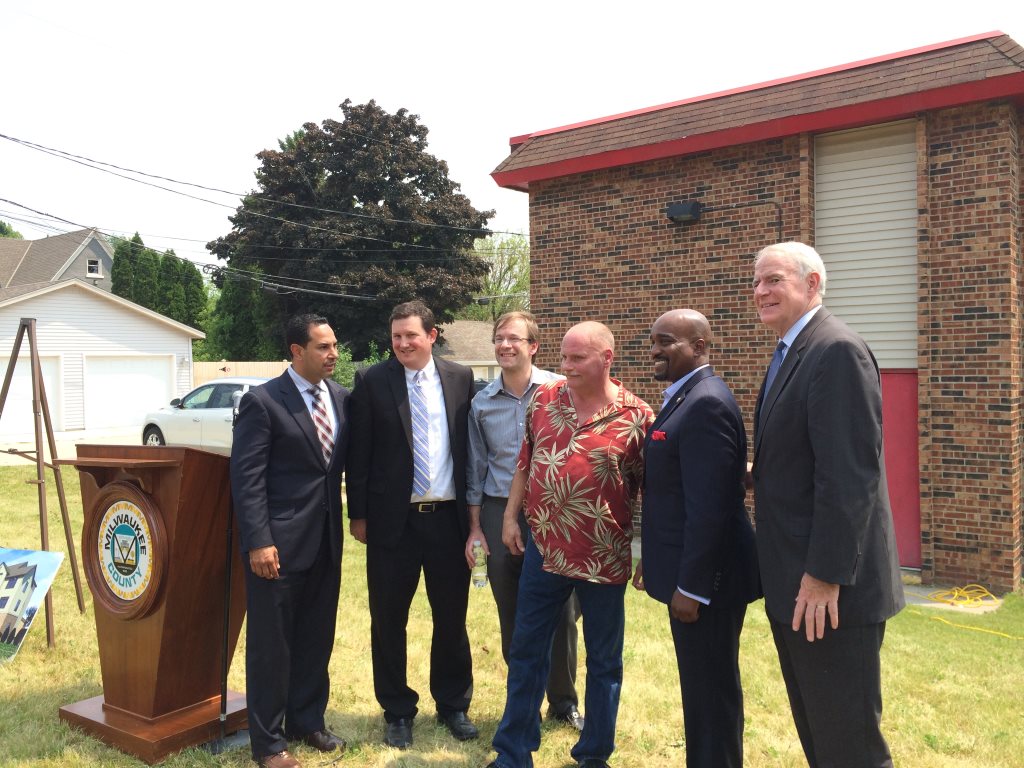County’s Homeless Program A Success
Based on national model, which found providing housing actually saves money.

Hector Colon, Jim Mathy, Chris Abele, Mark Hilton, Antonio Riley and Tom Barrett announce the Housing First plan in June 2015 at the Thurgood Marshall Apartments. Photo by Hayley Keith.
“I think we’ve made a lot of progress. We’ve seen a pretty significant reduction.”
This sums up Eric Collins-Dyke’s assessment of homelessness in Milwaukee County, two years after the launch of a program he says “flipped previous programs on their head.”
Collins-Dyke, who has a professional background as a social worker, is outreach services manager with Milwaukee County Health and Human Services’ housing division. He has received a number of accolades over the years, including being named to the National Alliance on Mental Illness’ Advocate of the Year award in 2014.
In the past two years, much of his effort has been directed toward Housing First, a program tailored to the county’s chronically homeless population.
As the National Alliance to End Homelessness notes, studies have found the Housing First approach saves money: One study found an average cost savings on emergency services of $31,545 per person housed in a Housing First program over the course of two years. Another showed that a Housing First program could cost up to $23,000 less per consumer per year than a shelter program.
In Milwaukee County’s program, once the homeless have a place to live, specialists work with them on a case-by-case basis and try getting at the root causes of their homelessness.
Collins-Dyke, beaming with enthusiasm as he discusses the program, calls it a “no-brainer” to bring this approach to Milwaukee County. Attempting to address a person’s needs without first ensuring he or she has a stable place to live has proven an uphill battle in the past.
Statistics show Housing First has put a dent in the county’s homeless population. According to the Institute for Community Alliances, 1,521 persons across Milwaukee County were homeless at least one night in 2015. Today, Collins-Dyke pegs that figure somewhere in the range of 900 to 925 persons.
“It’s probably the most dramatic decrease we’ve seen,” Collins-Dyke says. “The figures were stagnant before (2015).”
The county has set some lofty goals to eradicate chronic homelessness. County Executive Chris Abele, who created Collins-Dyke’s position amid a broader campaign pledge to reform and redesign the county’s mental health system, has announced a goal of serving 300 homeless persons through Housing First.
To date, more than 200 chronically homeless persons have been placed in residences through Housing First. Retention rates during the past two years of the rollout have stood at 99 percent, according to county figures.
The Housing First strategy was first used in the mid-1990s in New York City and has been replicated in a number of disparate urban centers across the U.S.
Collins-Dyke says Milwaukee County version of this increasingly popular approach is unique in one way. Few governments take such a prominent role in implementing the program.
“We’ve been progressive in that way,” he says.
Collins-Dyke says partnerships have been the backbone of Housing First’s impact on the county’s overall homeless population the past several years. Notably, the City of Milwaukee has been an important part of the program. The city’s housing authority has worked in tandem with the housing division at the county level.
But a raft of advocacy groups have also assisted Collins-Dyke and others within the health and human services department of carrying out the goals of Housing First.
The list of partner organizations includes 2-1-1, The Cathedral House, Center for Veterans Issues, Community Advocates, Grand Avenue Club, The Guest House, Hope House, Milwaukee Police Department, Path Finders, Salvation Army, Substance Abuse and Mental Health Services Administration (SAMHSA) and the United Way of Greater Milwaukee and Waukesha County.
Looking ahead, Collins-Dyke said he and others are optimistic — but cautiously so — about the continued rollout of Housing First. Federal and state funding, he notes, have been an important part of the program. If contributions are reduced, its effectiveness could wane.
“But we feel very good about where we are right now,” Collins-Dyke says.





















How do you refer someone to get help with “Housing First?” I encounter two or three people a week on the east side who look like they are living on the street.
@Maureen Here is the Housing First website: http://www.housingfirstmilwaukee.com/
The Housing First program takes all referrals through the Coordinated Entry system, providing a single point of referral to housing and other services for the homeless. Most housing programs funded by federal and state funding in Milwaukee County are in Coordinated Entry. Please ask anyone you meet experiencing homelessness to call 2-1-1 to access referrals for services. They can also call 211 to get connected to Street Outreach workers who can work with clients through the process to get housing, which will entail a wait and creates a need for a partner who understands the process and can help get basic needs met. The following agencies have street outreach services: Outreach Community Health Centers, Community Advocates, Milwaukee County, IMPACT, and Pathfinders. Generally if someone has gone to a meal site or other hub for human services in Milwaukee they probably have met with street outreach at the site.
How do people who don’t have a home and probably don’t have a phone call 2-1-1?
Maureen, a homeless person can call 866-211-3380 from a payphone.
http://city.milwaukee.gov/commoncouncil/District4/211SocialService#.WaQGc4Uw87A
There is an option to text 211 if out of minutes, or can use another person’s phone number for call back, many use safe link for assistance with getting a phone if they have foodshare or badger care benefits, or have access to 211 through social service contacts who let them know when they get closer to housing placement.